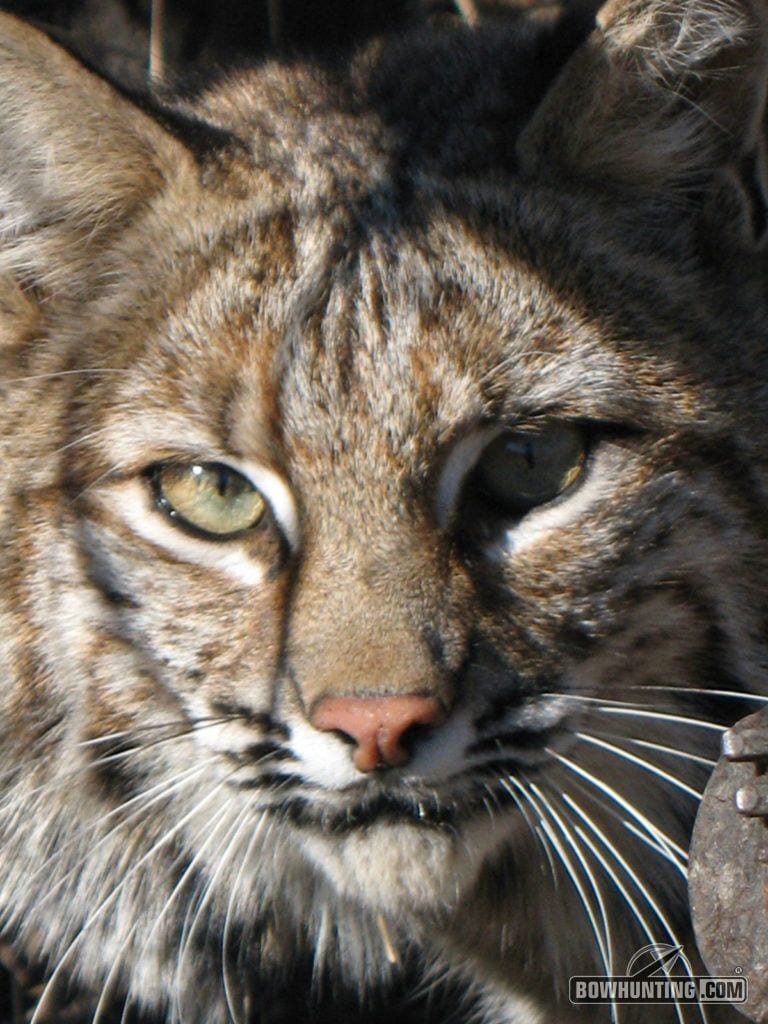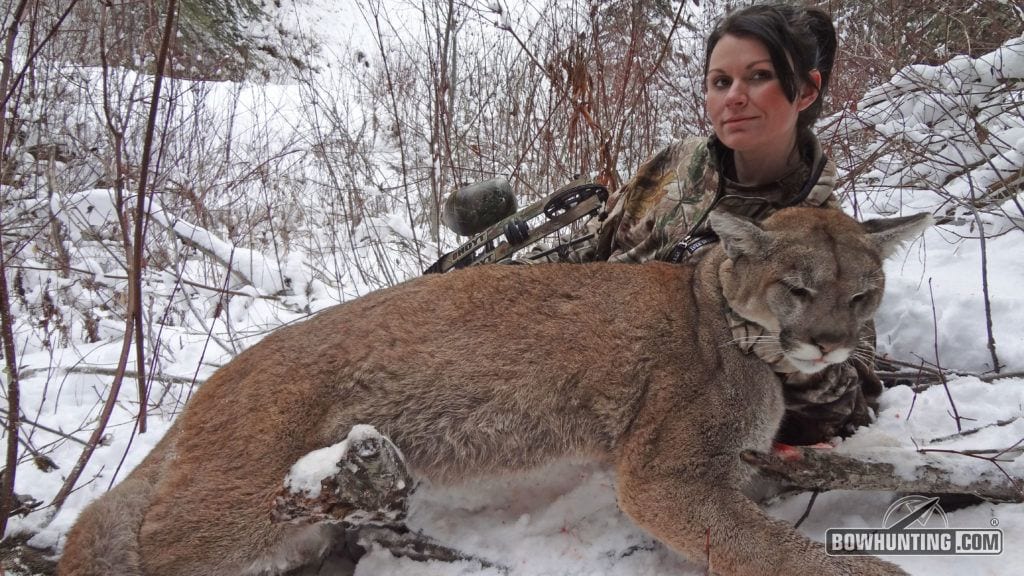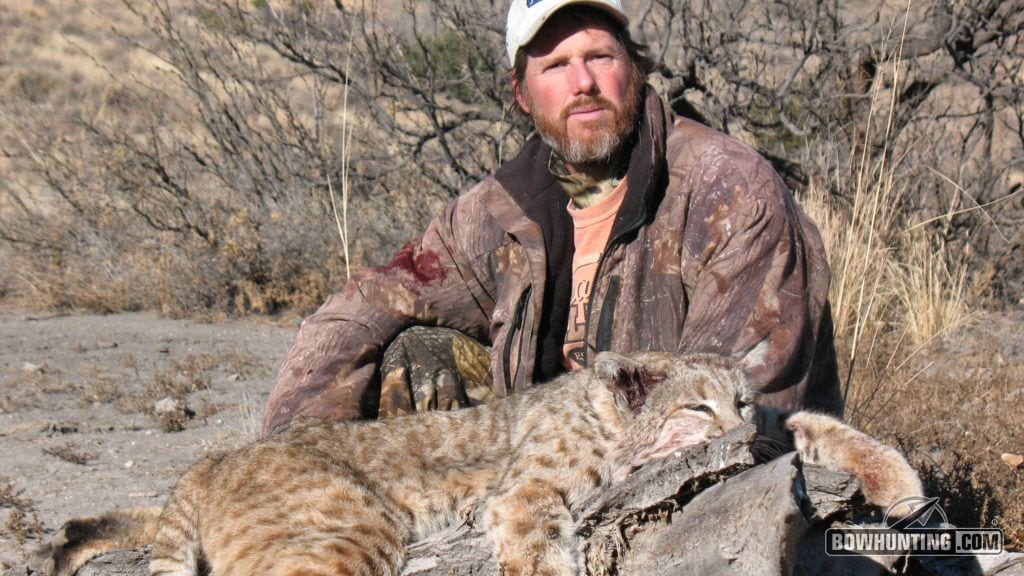Wild cats, North America’s ultimate predators, have always proved fascinating to hunters. Whether it’s 10- to 25-pound bobcats or 90- to 180-pound mountain lions or cougars, there’s something truly mystic about these apex felines. They’re hunters like us, using stealth and patience to stalk and kill anything from hares and grouse (bobcats) to deer and elk (mountain lions). As bowhunters we spend a lifetime striving to hone skills these cats use on a daily basis to survive. Even in areas where they are quite prolific, ghost-like cats are a rare sight. You might witness one in the vehicle headlights late at night, but it’s truly rare to behold 
This makes America’s cats hard-won bowhunting trophies. Bobcats are occasionally called into archery range while predator calling, or witnessed while sitting tree-stands, but their hyper-attentive demeanor makes clean shots challenging at best. For bowhunters seeking a high-odds opportunity at a bobcat or mountain lion, hunting behind well-trained hounds is the obvious solution.
The truth on chasing winter cats? It’s tough. But you can pull it off. Here’s how…
Booking Adventure
Most of us will be dependent on outfitters with a pack of hounds—or good friends willing to take us along between paying clients. For most taking a bow cat means finding an outfitter with a good reputation and booking a hunt. The best references come via word of mouth, or an acquaintance that has hunted with someone and highly recommends the experience. Advertisements are another avenue, but this comes with responsibilities. First, interview your perspective outfitter, assuring the two of you see eye to eye, and then request recent client references (both successful and unsuccessful) to gain additional insight. Query past clients for more clues into how hunts are conducted (assuring your expectations will be met) and what gear you might want to choose. Glowing reviews from unsuccessful clients, in my estimation, are the mark of a quality outfit, as the man who gets his prize is often willing to overlook problems and incompatibilities.
It’s also your job to arrive prepared for the conditions you’ll likely face. While it’s always a good idea to arrive in top physical condition, you might learn the outfitter’s area is well interspersed with logging roads passable with snow machines or ATVs and marathon-like stamina isn’t imperative. In other areas you may have to work harder, trudging miles on foot across snowy mountain terrain. In still other instances you may be spending hours in the saddle atop mules or horses. This also dictates how you dress and the weapon packed.
Dress For Success
Choose footwear accordingly. If you’ll be hunting from snowmobiles or ATVs and able to drive within a reasonable distance before approaching a treed animal, warmth might be more important than mobility. Pac boots, like Rocky’s Blizzard Stalker Pro, are often preferred in these situations, as feet can become chilled speeding along on an open sled/ATV. If you’ll be riding horses/mules, followed by climbing in rough terrain when the race enters country too rough to ride, an insulated boot with uncompromising traction and ankle support is in order. No matter what you choose, make sure it’s waterproof as snow, mud, and frequent creek crossings can be a large part of any hound-chasing adventure.
Regarding clothing, a smart layering system is absolutely mandatory. You can be sitting atop a cold snowmobile or riding a horse beneath snow-covered trees one hour, trudging up a vertical chute of boulders another, or simply pushing hell bent for leather through wooded or mountain terrain to keep the race in earshot. Start with a base layer that wicks away sweat to prevent overheating while climbing or slogging.

Mountain lions will take you into some of the nastiest weather and roughest terrain you can imagine. You better be dressed for success.
Your next line of defense against the elements should be a packable insulating layer, a vest or jacket, that occupies minimal pack space when not in use; like Sitka’s Kelvin line or First Lite’s Uncompahgre Puffy. Finally, choose an outer layer that’s at least highly water and wind repellent, if not outright waterproof. This final layer is dictated by prevailing temperatures. It can get downright chilly during winter hound hunts, especially at northern latitudes. All around, I like Sitka’s 90% Jacket and Timberline Pants (the knee pads are great while riding horses through thick vegetation or around tree trunks). For cold rides, First Lite’s Sanctuary jacket and bibs are super warm, though once you begin hiking they will need to be left behind.
A sturdy daypack is obviously needed. I like something in the mid-size range that can be easily hung over a saddle horn or lashed to a snow mobile/ATV rack while riding.
Choose Your Weapon
In bowhunting you have two choices while chasing hounds—your trusty, fully-rigged compound, or a take-down recurve. Now understand, a compound can become maddening while riding a horse (a special scabbard is in order, as holding it in your hands all day can become a serious burden), while traversing treacherous, cliffy terrain that mountain lions often retreat into or while negotiating extra-thick brush. Even the most compact compound snags on every passing twig, and when pushing through brush or clambering through life-threatening topography you really need complete use of your hands. Many packs include systems for securing bows, but in thick brush this can prove more frustrating than carrying an unwieldy compound by hand. If you must shoot your compound, go ahead, but you’ve been warned.
When chasing hounds (which I did as an outfitter for many years) I prefer a take-down recurve. A disassembled recurve packs easily into a larger daypack, leaving hands free and your profile streamlined. My favorite has long been the Bear Archery Takedown (various riser and limb configurations allowing 56- 60- and 64-inch bows) because they assemble nearly instantly without tools; though I’ve used others holding standard limb-bolt limb anchoring, stashing proper-sized Allen wrenches in three different pockets to assure I could get my hands on one when needed.
Obviously, mastering a recurve requires a bit more practice, but shots at treed cats are seldom taken at more than 20 yards and you’ll have plenty of time. The occasional lion will bay in cliff or inside caves, but this is unusual.

The author with a beautiful cat. Bobcats provide one of the toughest challenges a bowhunter will ever face.
Cat Missiles
Arrows are the final part of the equation, and when shooting a recurve, you’re biggest problem. One option is to choose a rugged back quiver, such as Rancho Safari’s CatQuiver, a back quiver/daypack combination. Even then I wrap duct-tape around the lower broadhead cradle to assure arrows won’t dislodge in rough terrain or while fighting thick brush. I’ve also had good luck removing broadheads, bundling arrows with rubber bands and shoving the works into my daypack, fletchings sticking from the top.
Hunting behind hounds isn’t bowhunting in the strictest terms, but it’s a mode of operation as old as hunting itself and a real adventure. Rest assured, when the hounds began to tune up on a hot track, flowing over the nearest ridge or across an adjacent canyon, reaching a fever pitch as the quarry takes to a tree, it’s the truly jaded sport that’ll cause your pulse to race and imagination to run wild. Many seem to think you are only stealing the glory rightfully belonging to the dogs, but in reality this is a collaboration as old as mankind himself, where the hounds are there for you and you are there for them. In the end everyone involved has a grand time and is ultimately happy for it.

 By
By 



